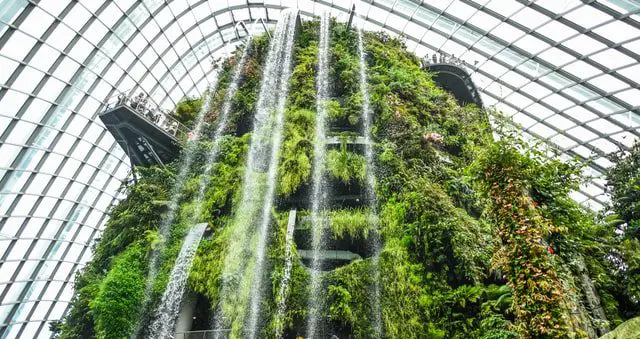Green Building advantages are discussed very often in the industry, but are there even disadvantages?
Buildings are a very important part of our life. We live in them, work in them, and spend our free time in them. People are spending approximately 90% of their time indoors, so it is important to keep these spaces comfortable and enjoyable for the tenants.
But not only comfort plays a big role these days, but it is also important to keep the ecological footprint of real estate as low as possible. This is where the concept of a green building shows how significant it is. It can have many advantages to implement green solutions and technologies, such as a more sustainable usage of resources and also a great return on the investment.
In the following article, we will look at these topics in more detail and point out the disadvantages that are currently a challenge for the development of green buildings.
Green Building Advantages and Disadvantages
Green Buildings have many advantages such as reduced energy consumption, reduced operating costs, sustainable usage of resources, reduced CO2 emissions, increased productivity and quality of living. On the other hand, some downsides are the initial investment, finding the right technologies and materials, finding experts, and that the success depends on the location.

[formidable id=5 description=true]
Advantages of Green Buildings
- Reduced Energy Consumption
One of the main plus points of green buildings is that they are able to reduce energy consumption to a great extent. There is a huge potential in savings on a global scale, as commercial and residential buildings account for a major part of this consumption. By utilizing smart HVAC systems, smart lighting, better insulation and intelligent placement of windows, usual energy consumption can be reduced and supported by renewable sources.
- Reduced Operating Costs
Green Building technology is helping to minimize operating costs in a few different ways. First, because of the reduced energy consumption, the costs for sourcing it from the public network will also be lower. In many cases, renewable technology such as solar panels can even account for additional income for the building by selling electricity back to the public.
- Sustainable Usage of Resources
Another green building advantage is that resources such as water, building materials, plastic and energy will be used more sustainable. Water consumption can be reduced by using new plumbing technologies, reusing used water and also by collecting rainwater. Some of the sustainable building materials can be bamboo, earth, wool, recycled steel and recycled concrete.
- Reduced CO2 Emission
As the building sector accounts for a large part of the global CO2 emissions, a big green building advantage is that it can reduce these by a lot. By relying on sustainable materials, smart building technology, IoT and renewable energy sources, there is a big potential for improvement.
- Increased Productivity of Tenants
Studies have shown that thanks to better air quality, performance of employees in offices can be increased by up to 8 percent. Not only does this bring health benefits for everyone, but can also help a company’s productivity.
- Improved Quality of Living
Another green building advantage is the improved living quality for tenants. Because of the better lighting conditions, the improved climate and temperature, there are various health benefits for the people living and working in these green buildings. These include better cognitive functions and better sleep.
Our Book Recommendation For This Topic
The Book “Sustainable Construction: Green Building Design and Delivery” provides you with an in-depth explanation of green building principles with LEED certification in mind. It covers topics related to engineering, architecture, construction, economics and financial return. The author, Charles J. Kibert, is a design and construction consultant who was involved with some of the first LEED-certified buildings in the US.
*Advertisment – Affiliate Link
Disadvantages of Green Buildings
- Initial Investment
Even though green buildings can provide a great return on investment within a relatively short amount of time, there has to be an initial investment at the beginning. Depending on the goal and how many technologies and solutions have to be implemented, these can rise quite high.
- Identifying the Right Technology for Individual Buildings
A disadvantage is that it can become very hard to identify the right technology for each building. As every house is different and at a different location, there are some technologies that might be more beneficial. - Finding Green Materials
Aside from the technologies, it can also be hard to source green building materials. These are often not available everywhere around the world and will have long delivery times, especially because of the current trend of green buildings. - Finding People with Expertise
Another green building disadvantage is that the industry is still quite new and has only recently seen more and more developments. This means that there is also a lack of professionals and experts that can help with these topics.
- Success Depends on the Location
Lastly, another disadvantage is that the success of a green building can also depend on the location. Because of the climate and difference in temperatures, some technologies might not work as well as others.
The 5 Principles of Green Buildings
There are five main principles that define the characteristics of a green building. Architects, engineers and developers should aim to achieve these goals in order to create a truly sustainable property.
1 | Sustainable Design
One important aspect is to design and plan the building with sustainability in mind. This has to be done right from the beginning, as later upgrades can be costly and difficult to install. Natural lighting and ventilation are architectural elements that should be included. Additionally, greenery, green roofs, and rainwater harvesting are aspects that can contribute to a sustainable building as well.
In order to achieve the best results, a sustainability certification like LEED or BREEAM can be used. These companies provide consultants and professionals that assist with the design and planning process.
Overall, during the design phase, it is important to keep a number of factors in mind. They include materials, transportation, water, energy, and waste.
2 | Durability and Quality
The second principle of green buildings is durability and quality. It is crucial that modern buildings have a long lifespan, in order to minimize waste and energy. Therefore, durable and sustainable materials must be used that improve longevity and also reduce the amount of embodied carbon.
Floor plans and interior design must be flexible to accommodate multiple tenants over the upcoming decades. Due to different requirements from commercial occupants, a change of the property might be necessary. A flexible layout ensures that this process goes fast, easily, and without much waste.
3 | Sustainable Sites
Not only the building needs to be green, but also the site where it is constructed. That’s why the third principle focuses on the impact of real estate on the surrounding environment.
A few factors need to be considered when developing a sustainable site. The climate needs to be appropriate for the desired building plan, public transportation should be available in close proximity for residents, and the local community should be included in the decision-making process.
Furthermore, it is also important to analyse the environment and what species might be affected by the new development.
4 | Clean and Efficient Energy
Improving energy consumption has to be one of the highest priorities. To create green buildings, it should be the goal to receive energy from renewable sources, such as solar panels. These are a common solution that can be found in many modern and refurbished properties.
In addition, the building’s energy management must be as efficient as possible by using low-consumption appliances, smart meters, and smart HVAC systems (just to name a few).
This aspect is crucial to reach net-zero emissions within the next decades. Also, due to the current energy crisis in many countries, a reduction in energy consumption can significantly reduce operating expenses.
5 | Waste Reduction
The fifth principle of green buildings is waste reduction, which includes recycling and re-use of resources.
In a building, wastewater or rainwater can be reused to provide water for toilets and for plant irrigation. The heat from inside the rooms can also be reused to reduce overall energy consumption. This process is called heat recovery and can greatly improve HVAC systems.
Another important part of waste reduction is to refurbish buildings, instead of rebuilding them. During the demolition phase of a property, a lot of valuable materials are going to be lost that could be saved if the property is refurbished.
In some cases, for older or complex properties, it might not be feasible to refurbish them. In this situation, the remaining materials from the site, such as steel or concrete, should be recycled as much as possible.
Conclusion
Overall, green buildings have many advantages that can help to make the building sector more sustainable but also profitable. Some of the advantages include reduced energy consumption and CO2 emissions, reduced costs, improved productivity and quality of living. Currently, there are some downsides that will most likely change within the upcoming years, such as, the initial investment and expertise.
If you want to learn more about the future of commercial real estate, including topics such as sustainability & ESG, PropTech, architecture, development and investment, feel free to take a look at our other articles on Smart CRE. Here you will also find insights into the job market and how to start a career in real estate.
To stay up-to-date, we would be very happy if you subscribe to our monthly newsletter. Just enter your e-mail address below. Thank you!
